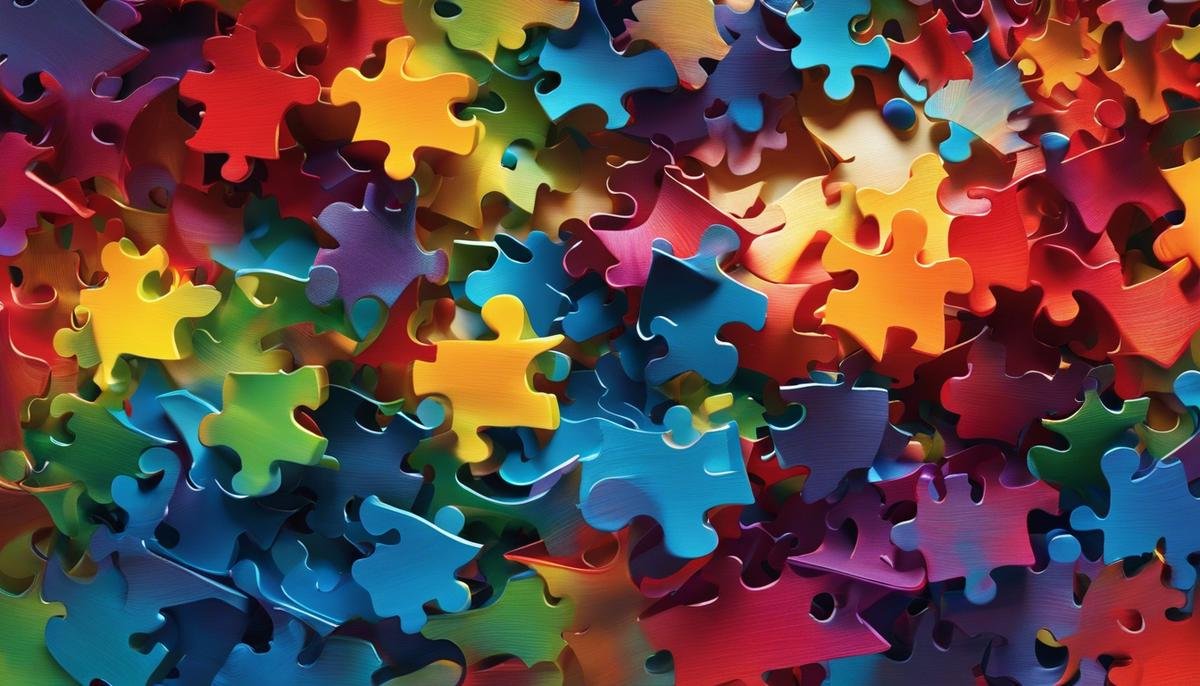
Autism, a complex neurodevelopmental condition, frequently makes its presence known in unique communication methods, one of which is echolalia. Echolalia, the repetition of phrases or words, is commonly observed among individuals on the autism spectrum. However, it is often surrounded by a haze of misunderstanding and assumptions. This paper steps into that fog, breaking down the intricacies of autism and particularly, echolalia. You’ll be guided through a comprehensive understanding of what autism and echolalia are, signs to look for, the reasons behind such an approach to communication, and practical communication techniques and strategies for parents and caregivers. In doing so, we aim to foster empathetic understanding and provide useful information for facilitating effective communication.
Introduction to Autism and Echolalia
Understanding Autism and its Connection With Echolalia
Autism, more specifically known as Autism Spectrum Disorder (ASD), is an intricate, multifaceted neurobehavioral condition that encompasses a wide range of symptoms. This spectrum highlights the variability and unique attributes that each person with autism possesses. Some are non-verbal while others love to communicate; some may find it difficult to make friends, while others thrive in social situations. The common threads are differences in social interactions, communication and sensory behaviors, and a unique, often repetitive, pattern of interests and behaviors.
In a world where every autistic individual may exhibit different traits, we notice a phenomenon, quite common in many young children with autism, known as echolalia. Have you ever heard that term? Let’s navigate through what this term entails and its correlation with autism.
Echolalia is a term coined to describe the repetition or ‘echoing’ of words and phrases. This repetition can be immediately after hearing the phrase or sometimes long after hearing it, often without understanding or context. Echolalia is a natural part of language development found in many toddlers, but when it extends well past the developmental stage, it may hint towards autism.
For an autistic child, echolalia is a way to communicate in a world that often feels overwhelming and confusing. Sometimes, it can act as a calming mechanism to soothe their overwhelmed senses. Other times, it can be a way of reiterating what they’ve heard, effectively using it as a learning tool.
Parents and caregivers, don’t despair! Echolalia, rather than being a cause for concern, can indeed be an avenue for potential growth when guided and utilized correctly. How? Be patient and resist the urge to correct each echo. Instead, when a child echoes a phrase, reply with more conversation to encourage a back-and-forth interaction.
For instance, if an autistic child says, “You want a cookie?” when they want a cookie, clarifying with a query like “Oh, you want a cookie. What kind of cookie would you like?” This provides clarity without directly correcting the child and allows them to gain confidence in their communication skills.
Moreover, using visual aids like picture cards and social stories can also be helpful to encourage usage of language in context. The bridge from echolalia to functional speech may not be immediate, but it’s a journey worth embarking on.
Understanding autism takes patience, acceptance, and a lot of love. And while the connection between autism and echolalia might seem complex and overwhelming, taking it one step at a time makes all the difference. Raising a child with autism is not a battle to be won but a journey to be lived – a rainbow-colored journey full of unique triumphs and learnings!
In the end, every child brings something amazing to the world with their uniqueness. Their unique ways of viewing the world can introduce us to new perspectives, making life that much more beautiful. Embrace the quirks, celebrate the milestones, and love them for who they are. Because, in that love and acceptance, we foster a world where they can truly flourish and shine.
Remember, the journey may be unique, but the love is universal.

Signs and Symptoms of Echolalia in Autism
Recognizing and Understanding Echolalia in Autistic Children
From a parent’s perspective, it’s both a journey of discovery and a valuable learning experience when we become aware of how our children express their feelings, needs, and experiences. Each child is unique, with their own strengths and challenges. For children with autism, their expression often goes beyond the norm, and one notable way they do this is through echolalia.
Echolalia is the repetition or ‘echoing’ of phrases or sounds made by the self or others. It may be immediate, happening at the moment, or delayed, in which the echoing occurs hours or even days after the initial sound or phrase. Understanding this unique response can offer a gateway to the heart of a child with autism and provide valuable insight into their world.
Recognizing Echolalia: Signs and Symptoms
The first step in supporting a child with autism who exhibits echolalia is recognizing this behavior. Some signs to watch out for include:
- Repeating a Sentence or Phrase: Often, a child with autism may repeat a particular phrase or sentence, which may not seem to relate to the present situation directly but could have a hidden, significant meaning to them.
- Echoing Own Speech: The child might repeat their own question or statement, often immediately after they have said it.
- Echoing Others’ Speech: Recurrence of someone else’s spoken words or sentences is another common symptom associated with echolalia.
- Contextual Echoing: Sometimes, the child may repeat dialogues or phrases from a favorite TV show, movie, or book, potentially in response to similar scenarios or triggers in their environment.
It’s important to note that recognizing echolalia should not cause alarm or be seen as a setback. On the contrary, it can be a valuable key to understanding a child’s interests, thoughts, and emotions.
Why is Understanding Echolalia Important?
Understanding echolalia and its implications plays an essential role in nurturing the growth and development of a child with autism. While echolalia might appear to be just parrot-like repetition, it’s often a building block for meaningful language and communication. It can also be a coping mechanism, a way to maintain focus, or express joy and engagement.
By observing patterns in a child’s echolalia, parents can find clues about what situations make their child uncomfortable or happy, what phrases or sounds intrigue them, and how they perceive their world.
Taking Steps Toward Better Understanding
While some children outgrow echolalia, others may use it as a lifelong communication tool. Providing a supportive environment that fosters understanding and promotes constructive interaction is paramount. An approach that positively impacts echolalia includes picking up on the child’s interests, using simple language, giving the child ample time to process information, and using their echolalia patterns to teach new phrases and concepts.
Above all, remember that fostering an atmosphere of warmth, empathy, and acceptance can go a long way in helping a child with autism navigate the world, with echolalia being just one part of their unique journey.
Let us all continue to celebrate the beauty in diversity, promote understanding, and champion the cause of acceptance, in an effort to kindle a world that cherishes every individual’s unique capability and personality. An attitude of love, patience, and acceptance is truly the cornerstone of helping children with autism, and in fact, all children, to blossom and reach their full potential. Time indeed is the most precious gift we can give them, as we help them navigate their world.

Understanding the Reasons Behind Echolalia in Autism
Revisiting Echolalia in Autistic Children: The Road to Connection and Understanding
While previously covering a range of topics from the unique nature of ASD to ways to employ echolalia for language development, there’s still plenty to unpack about this phenomenally intriguing way some autistic children communicate. This yarn is intimately twined with family bonding and a sense of belonging; feelings we all strive to foster in our cozy little homes.
So, how about we delve deeper? Let’s try to decipher the echolalia patterns that echo around our hallways and explore the paths that can lead us to a stronger, understanding bond with our little champions.
Reading the Echolalia Signs
Echolalia is often characterized by repeated phrases or sentences, quite like an echo. It’s essentially like our little ones are playing back a recording. Everyday phrases like “time for lunch” might be repeated immediately or even after a considerable delay. Echolalia may also consist of dialogue from cartoons, commercials, or any auditory stimuli, really.
Understating the Why in Echolalia
Understanding the “why” behind echolalia is crucial to smoothing out the path to communication. It may be a form of self-stimulation, similar to how some children enjoy spinning or rocking. Or perhaps they’re rehearsing dialogue like actors practicing lines! It’s essential to remember that echolalia, like every aspect of autism, is as unique as each beautiful star in the sky.
Echolalia Patterns: Navigating the Labyrinth
Observing patterns in echolalia can let us in on what our little ones are trying to traffic through their neural expressways. Is it always after a particular event? Or maybe during certain times of the day? Unravelling echolalia can be like working on a puzzle – and who didn’t revel in the satisfaction of that final piece clicking into place?
Growing Together: Steps to Understanding and Communication
While on this enlightening journey, remember to make mind notes and even physical ones, of every echolalic phrase. These could be valuable breadcrumbs leading us through the forest of communication development. Experimenting with communication styles, from spoken language to touch and visual aids, can open multiple channels, making it more about exploring rather than fixing.
Building a Sanctuary of Support
Our homes should be comfort zones where our little warriors can take off their armors and be themselves, full of authenticity and without fear of judgment. Using love, patience, and the right educational tools, we can turn our homes into the laboratories of learning and cathedrals of care where each quirk is celebrated, not corrected.
Championing Acceptance and Diversity
In the grand scheme of things, parenting is about acceptance and understanding, not just for autistic children but for all children. We’re building a world where difference is embraced, and diversity is lauded. We, as parents and caregivers, are not just narrators but listeners in this shared journey, creating a tune that embraces echolalia, cherishing every note as the music of unique expression.
Weaving together the threads of patience, understanding, and love, we’re not just creating a tapestry of acceptance; we’re crafting a legacy of connection. And in this vividly diverse, warmly accepting world, every child, autistic or otherwise, shines brighter than the sun, etching their unique glow onto the canvas of our lives.

Parenting Strategies for Children with Autism and Echolalia
There’s no denying that every child is unique, each showcasing a sparkling blend of skills, quirks, talents, and even the way they express themselves. Children with autism, including those who employ echolalia, require a slightly different communication approach. Importantly, parents can adopt various strategies to communicate more effectively with their child.
Echoing or repetition, commonly known as echolalia, is often seen tied with autism spectrum disorder. However, it is not something to be feared or discouraged. Instead, it should be viewed as a stepping stone towards creating a meaningful bridge of communication. So, let’s explore some approaches that can be utilized.
Understanding the Function of Echolalia
This is the key to fostering communication. Sometimes, your child may use echolalia as a self-soothing mechanism or to fill a silence. It might be seen as ‘conversational turn-taking,’ giving you a clue it’s your turn to speak. So, recognize its function and engage accordingly.
Follow the Leader
Use the ‘mirroring’ strategy to engage your child. If your child echoes a phrase from a favorite show, join in! This strategy may encourage reciprocal communication and make them more comfortable in taking the lead sometimes.
Model Appropriate Responses
Taking advantage of echolalia to teach appropriate responses is another effective strategy. Create scenarios where your child can learn the usage and meaning of new sentences. For instance, practice simple exchanges like ‘How was your day?’ and model different responses.
Fun with Flashcards
Visual cues are beneficial for children with autism as they provide clear and concrete information. Consider creating a collection of flashcards based on your child’s routines, favorites, or most used phrases. They can be especially handy during challenging transitions or to initiate communication.
Rephrase Comments as Questions
If your child uses echolalia sentences as comments, help them convert it into a question. For example, if they say “I want a cookie,” model it as, “Can I have a cookie, please?”
Just like every child, those with autism, including who use echolalia, have their strong suites and are constantly learning and growing. Use this journey to better understand your child’s unique language, cultivating an environment where they feel heard, understood, and loved. You may be amazed at their progression.
Remember, the world will only become a better place for our children if we model the acceptance and kindness we want to see. So, celebrate every word and sentence, every attempt at communication, for it’s another step closer to understanding and empowering your beautiful, unique child.

As we navigate the realms of autism and echolalia, it is important to acknowledge and appreciate the diversity and individuality in communication styles. Labeling echolalia as a ‘problem’ to be ‘fixed’ overlooks the reality that it forms an essential part of communicative attempts for many individuals with autism. By understanding the reasons behind echolalia, recognizing its signs, and implementing efficacious strategies, parents and caregivers can create a supportive environment that respects the uniqueness of their child’s communication style. Just as important, they can foster the child’s communicative development. Thus, echolalia, seen not as a barrier, but as a bridge, might just be a stepping stone on the path towards more fully understanding the enigmas of autism and communication.




